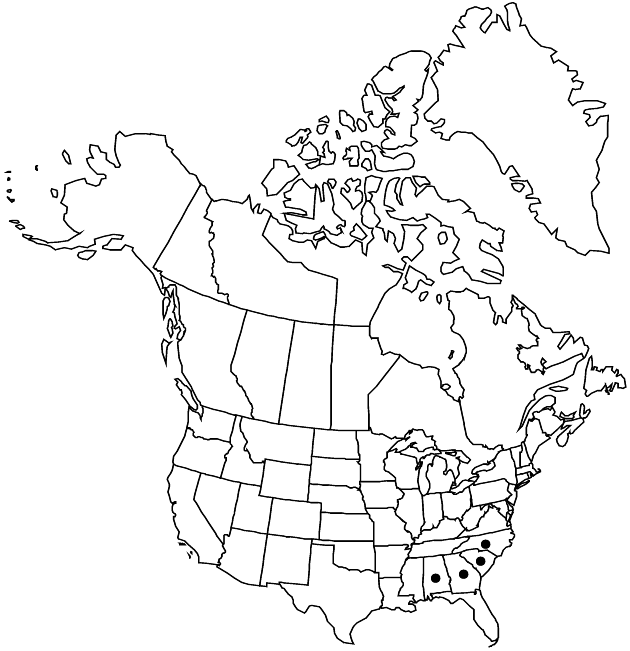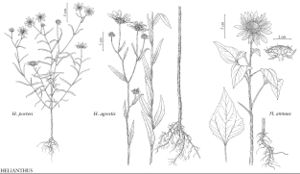Difference between revisions of "Helianthus porteri"
Castanea 63: 75. 1998.
FNA>Volume Importer |
FNA>Volume Importer |
||
| Line 15: | Line 15: | ||
|name=Heliomeris porteri | |name=Heliomeris porteri | ||
|authority=(A. Gray) Cockerell | |authority=(A. Gray) Cockerell | ||
| − | }}{{Treatment/ID/Synonym | + | }} {{Treatment/ID/Synonym |
|name=Viguiera porteri | |name=Viguiera porteri | ||
|authority=(A. Gray) S. F. Blake | |authority=(A. Gray) S. F. Blake | ||
| Line 33: | Line 33: | ||
|elevation=200–500+ m | |elevation=200–500+ m | ||
|distribution=Ala.;Ga.;N.C.;S.C. | |distribution=Ala.;Ga.;N.C.;S.C. | ||
| − | |discussion=<p>Helianthus porteri was established at Rocky Face Mountain, North Carolina, following its introduction as part of an ecologic experiment. Where it occurs, H. porteri produces conspicuous massed floral displays when in bloom. It is remarkably similar morphologically in its reduced habit, epappose cypselae, conic receptacles, and unlobed, mucronate pales to Heliomeris (Viguiera sect. Heliomeris), and it is treated under Viguiera in most southeastern United States treatments; its style appendages and chromosome number agree with molecular phylogenetic data in placing it within Helianthus.</p> | + | |discussion=<p><i>Helianthus porteri</i> was established at Rocky Face Mountain, North Carolina, following its introduction as part of an ecologic experiment. Where it occurs, <i>H. porteri</i> produces conspicuous massed floral displays when in bloom. It is remarkably similar morphologically in its reduced habit, epappose cypselae, conic receptacles, and unlobed, mucronate pales to <i>Heliomeris</i> (<i>Viguiera</i> sect. <i>Heliomeris</i>), and it is treated under <i>Viguiera</i> in most southeastern United States treatments; its style appendages and chromosome number agree with molecular phylogenetic data in placing it within <i>Helianthus</i>.</p> |
|tables= | |tables= | ||
|references= | |references= | ||
| Line 57: | Line 57: | ||
|publication year=1998 | |publication year=1998 | ||
|special status= | |special status= | ||
| − | |source xml=https://jpend@bitbucket.org/aafc-mbb/fna-data-curation.git/src/ | + | |source xml=https://jpend@bitbucket.org/aafc-mbb/fna-data-curation.git/src/8f726806613d60c220dc4493de13607dd3150896/coarse_grained_fna_xml/V19-20-21/V21_343.xml |
|tribe=Asteraceae tribe Heliantheae | |tribe=Asteraceae tribe Heliantheae | ||
|subtribe=Asteraceae (tribe Heliantheae) subtribe Helianthinae | |subtribe=Asteraceae (tribe Heliantheae) subtribe Helianthinae | ||
Revision as of 15:34, 18 September 2019
Annuals, 40–100 cm. Stems erect, usually sparsely strigose, sometimes hispid as well. Leaves mostly cauline; opposite (proximal) or alternate; petioles 0–0.2 cm; blades (± 3-nerved distal to bases) narrowly lanceolate to linear, 5–11.5 × 0.15–1 cm, bases cuneate, margins entire (often ± ciliate proximally), faces sparsely strigose or scabrous to glabrate, sparsely gland-dotted. Heads usually 5+. Peduncles 1–10 cm. Involucres hemispheric, 5–6 mm diam. Phyllaries 11–17, linear, 5.5–8 × 0.8–1.3 mm (margins sparsely hispido-ciliate, hairs 0.5–1.2 mm), apices acute to acuminate, abaxial faces glabrate, not gland-dotted. Paleae (ovate) 3.5–4.6 mm, entire (1-toothed). Ray florets 7–8; laminae (10–)15–20 mm. Disc florets 30+; corollas 2.8–3.5 mm, lobes yellow; anthers dark, appendages dark. Cypselae 2.2–2.3 mm, sparsely puberulent (bases and apices); pappi 0. 2n = 34.
Phenology: Flowering fall.
Habitat: Granite outcrops
Elevation: 200–500+ m
Distribution

Ala., Ga., N.C., S.C.
Discussion
Helianthus porteri was established at Rocky Face Mountain, North Carolina, following its introduction as part of an ecologic experiment. Where it occurs, H. porteri produces conspicuous massed floral displays when in bloom. It is remarkably similar morphologically in its reduced habit, epappose cypselae, conic receptacles, and unlobed, mucronate pales to Heliomeris (Viguiera sect. Heliomeris), and it is treated under Viguiera in most southeastern United States treatments; its style appendages and chromosome number agree with molecular phylogenetic data in placing it within Helianthus.
Selected References
None.
